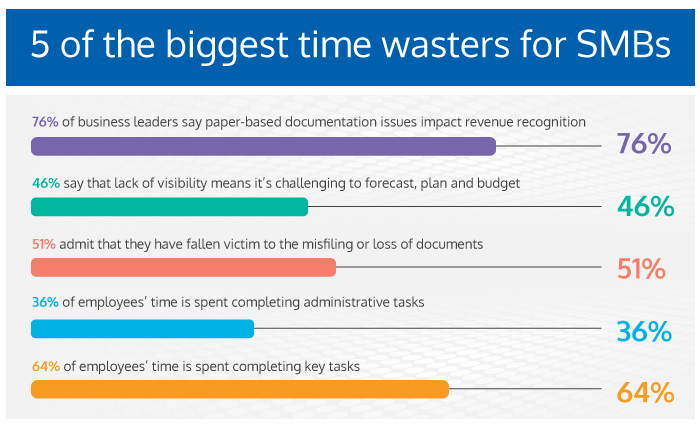5 of the Biggest Time Wasters for SMBs

Small and medium-sized businesses (SMBs) – defined by the Australian Bureau of Statistics[1] (ABS) as having fewer than 20 employees and between 20 and 199 employees respectively – are key players in the economy, contributing to around 60% of Australia’s GDP and 28% of New Zealand’s.
SMBs employ more than two-thirds of Australia’s workforce and almost 30% of New Zealand’s workforce. Those who work for an SMB cite a positive work culture, close relationships with colleagues and executives, and greater influence on the growth of the business as main advantages. But despite these strengths, SMBs confront many challenges – most of which are centred around limited budget, resources and time.
For an SMB to reach optimum performance and compete in their industry, it must use its resources – particularly time – wisely. Below are 5 of the biggest time wasters, with tips on how to avoid them:
1. Paper-based administration
It’s not uncommon for SMBs to complete recruitment, onboarding and payroll tasks manually and/or using paper-based systems as opposed to digitally. HR administrative tasks can be very labour-intensive and present several issues: performing large HR tasks manually eats up time and resources; when information/data is in physical form, it cannot be easily synced across multiple platforms; there is more room for inconsistency and human error; there are privacy and security risks; storing and filing physical documents takes up office space; and the excessive use of paper is not environmentally-friendly.
A whitepaper from IDC[2] talks about “document disconnect” and how organisations who are paper-based not only hinders employee productivity but poses a huge compliance risk. Some findings from the report are outlined below.
To maximise efficiency and productivity, SMBs should forego outdated paper-filing systems in favour of automated processes like ELMO’s seamless cloud-based payroll and HR solution. This way, business leaders and their HR teams (roles which are, for SMBs, often synonymous) can store, access and manage/analyse information and data in one place – on one interface. The result? Increased efficiency, increased productivity, and more time to do what really matters – building the business.
2. Unnecessary meetings
Team meetings are a big part of the working week, but they can also be the biggest waste of time for SMBs. A report by Ovum and LogMeIn[3] reveals that professionals in Australia and New Zealand are attending more work meetings than ever before, but that a staggering 66% are perceived as having “little or no value”.
Similarly, research by Deliveroo for Business found that the average Australian will attend 8864 meetings in their lifetime, but that more than half of those meetings (66.1%) are not constructive and are, therefore, a waste of time.
For SMBs, where resources are limited, excessive meetings are simply not practical. Doing the work is far more beneficial than talking about the work.
To ensure every meeting in your team’s calendar is a good use of time, heed the below tips:
- Ask yourself, is this meeting completely necessary? If the subject matter can be clearly communicated in an email, there probably isn’t a need to call a meeting.
- Set an agenda before the meeting commences. Create a shared document where you and your team can outline the topics to be addressed so that everyone is prepared beforehand. You may also add time limits to the agenda to ensure all talking points get enough airtime. This is helpful when the meeting in question is, for example, a weekly team WIP where there is a lot up for discussion.
- Cut the meeting time in half. This may seem ambitious, but allotting less meeting time encourages the attendees to address issues quickly and efficiently, which frees up time for other tasks.
- Be on-time. The Ovum and LogMeIn report found that repeatedly commencing meetings late wastes an average of 3 hours per week – that’s 5.5 days per year!
- Capture key points and distribute them after the meeting. Write down any solutions that were made in the meeting and highlight any areas still up for discussion.
3. Juggling too much at once
It’s not uncommon for SMBs to take a “do-it-yourself” (DIY) approach to all areas of their business. Team members may find themselves wearing multiple hats and juggling several responsibilities – even if they fall outside of their remit.
It’s been found that Australian SMBs commonly hire “sub-par” talent due to a number of factors hindering the recruitment process. Research has found that almost half of Australian SMBs (46%) find it hard to compete with big corporations for highly skilled workers[4], and that both Aussie and Kiwi SMBs face the challenge of employee retention, as job-hopping becomes the new norm[5].
This is problematic because when an employee lacks the expertise that their role requires, he/she may struggle to execute tasks effectively and may have to delegate to other individuals, either internally or externally, which is a huge waste of time and resources
Financial pressures are a concern for many SMBs, but they must put emphasis on talent to avoid falling by the wayside. If recruiting highly skilled workers isn’t financially viable, a SMB may consider enlisting external expertise by outsourcing specific tasks to professionals in specialised fields. For example, a retailer may outsource their accounting/finance to an external provider, or a local restaurant may outsource their digital marketing.
4. Micromanaging
Owners of SMBs are rightfully precious about their business, but they must be careful not to micromanage their employees. Micromanaging can make a small team feel undermined and distrusted, and this creates fractures in working relationships. Not to mention, micromanagement is a massive timewaster, as business leaders are less focused on the bigger picture.
5. Over-monitoring emails
Another huge timewaster is spending too much time on emails. A 2019 Adobe study found that professionals in the US spend more than 3 hours a day monitoring their work emails which, for time-conscious SMBs leaders, is a huge productivity-killer.
For SMBs where employees may feel pressed for time, email “blackout” periods may help to streamline work activities and boost workplace efficiency. It’s also worth considering if instant messaging and collaboration tools like Slack and G Suite might be a better option for some tasks.
Time is money
Most SMB leaders would agree that time is money, especially during the crucial start-up and growth phases. With some simple changes to processes and the right technology in place, it’s possible to claw back lost time and maximise organisation-wide productivity.
ELMO Cloud HR & Payroll’s end-to-end solutions streamline the entire employee lifecycle, from hire to retire. ELMO addresses all key employee-employer touchpoints, including recruitment, onboarding, performance management, payroll, rostering / time & attendance, and more, enabling better workplace efficiency and providing more time to focus on the strategic issues that have the most impact on business performance. To find out more, contact us.
[1] “Small business contribution to the Australian economy”, Parliament of Australia, 2018
[2] “Addressing the Document Disconnect: Hidden Opportunity, Big Payoff” IDC, 2015
[3] “Ovum Global Collaboration Study, n = 3926
[4] “Moments That Matter: Understanding Australian SMEs”, NAB Whitepaper, 2017
[5] “ELMO’s Ultimate Guide to HR Software for Small & Medium Businesses (SMBs) eBook”
 HR Core
HR Core 










